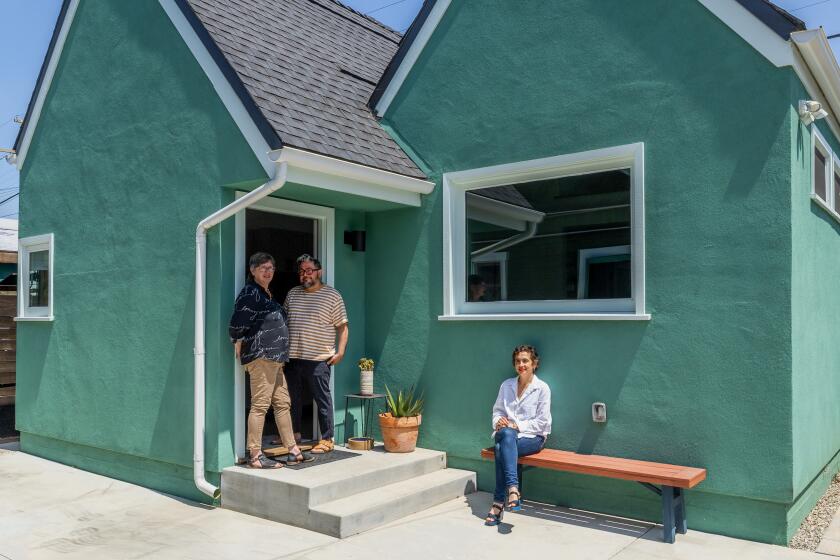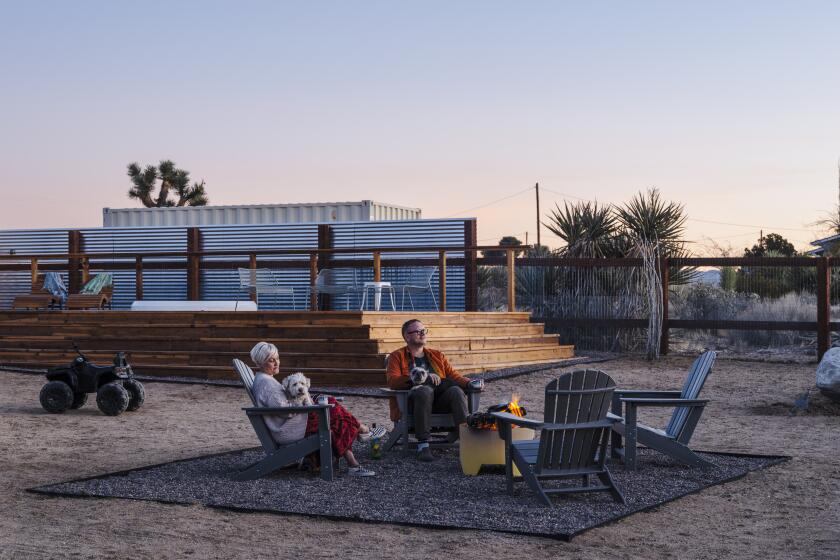Father Serra’s Statue Gets New Life--in Bronze : Landmark: The unveiling will conclude an at-times controversial $100,000 campaign to restore the memorial to its original glory.
For 53 years, there was something concrete about Father Junipero Serra’s standing in Ventura.
The priest who colonized Ventura by founding Mission San Buenaventura in 1782 was commemorated by a 9-foot, 4-inch cement statue that stood a lonely vigil overlooking the downtown business district.
That came to an end six weeks ago when the statue--ravaged by weather and by vandals--was taken, crumbling, from its stone pedestal.
As of Friday, Father Serra will be lonely no longer, however.
When a long-sought replacement statue is unveiled in front of Ventura City Hall, Serra will be memorialized in bronze.
Not to mention wood, wax, paper and the original cement.
The 7 p.m. ceremony concludes an at-times controversial three-year, $100,000 campaign by Ventura residents to restore the landmark to its original glory.
The event will honor a team of carvers that spent 10,000 man-hours fashioning a wooden replica of the statue and a group of student artists from the California Sculpture Center in Palm Desert who used it to mold a new bronze casting.
It will honor Ventura County residents who raised money for the project by buying T-shirts and hats, and local artists who aided the effort by producing 18-inch copies of the statue and lithographed posters that depict the original.
And it will honor sculptor John Palo-Kangas, the Meiners Oaks resident who hauled sand and gravel from the Ventura River to create the original statue in 1936.
“I think my father would be truly impressed and overwhelmed if he were still alive,” said Shirley Weeks, daughter of Palo-Kangas, who died in 1958.
“He would be really flattered by the community’s efforts. What they’ve done makes me feel proud and happy to be a citizen of Ventura County and the city.”
Her father was paid $5,000 through the Depression Era’s federal Works Projects Administration to create the statue in front of what was then the Ventura County Court House, Weeks said.
Palo-Kangas built it from concrete poured into a plaster mold formed from a chicken wire-and-clay model, she said.
“Being cement, I figured the statue would last forever,” said Weeks, who works as a records analyst for Ventura County. “I first noticed the cracks forming on the statue in the 1960s.”
Salty sea air and rainwater that collected over the years in the collar of Father Serra’s robe to perpetually saturate the concrete had taken their toll on the locally mixed aggregate. An attack by vandals didn’t help, either.
“Someone painted it brown and the paint dried before it could be removed,” said Carol Green, an assistant to Ventura City Manager John Baker. “In trying to get the paint off, we sandblasted it, which was the worst thing we could have done, we found out later.
“It was like taking the crust off bread. That just exposed the concrete more to the elements. We tried to fill it in with epoxy . . . but art and architectural consultants and a concrete expert we brought in all said the statue’s days were numbered.”
When the experts said the statue was too patched-up and crumbly to be used to create a new mold, the replacement effort using bronze cast from a wooden replica was suggested by former City Councilman Russ Burns.
A team of woodcarvers recruited from the Channel Islands Carvers club began scraping and chiseling a wooden replica in February, 1987, under the direction of master carver Wilbur Rubottom, a 75-year-old retired Ventura cabinetmaker.
Using 1,200 pounds of bass wood brought from a Great Lakes-area forest and 1,800 individual measurements taken from the original statue, Rubottom and seven other carvers finished their work 14 months later.
“All along we knew that the statue we were carving would only be used as a mold,” Rubottom said. “It didn’t bother us. Kangas had done an excellent job on the original. We were glad that such a historical statue would be preserved.”
After a new mold was formed from the wooden replica, the carvers polished it with eight coats of tung oil that gave it a luxurious, amber color. Then they turned the 800-pound copy over to the city.
That’s when the controversy erupted.
When the City Council decided to display the wooden piece in the City Hall atrium art gallery, there were protests.
The day before the replica was to be moved to the gallery last year, members of a city art committee and an American Indian group objected.
Committee members protested that the huge statue was “not harmonious” with the gallery. Indian representatives complained that the Serra statue was “a slap in the face to the Indian people”--some of whom believe that their Chumash ancestors were abused and enslaved by Serra and other missionaries.
City officials say the flap eventually blew over.
When a display of Chumash-inspired murals was dedicated in the City Hall gallery in September, Indians danced and sang without paying attention to the stern-faced Serra, Green said.
Most City Hall visitors believe that the statue fits nicely in the gallery, Green added.
“It’s like any artwork. Some people like it there and some don’t. But the majority seem to like it,” she said.
The original concrete statue has suffered a different fate--at least for now.
Today it lies on its back on a Ventura Avenue loading dock tucked away in one of the city’s poorest neighborhoods. The statue is cradled in foam packing material and boxed in a specially braced wooden crate so that only its crumbling cement base shows.
Eventually, officials say, the plan is to patch up the statue’s cracks as best as possible and display it in the foyer of a proposed county agricultural museum in Camarillo.
That is appropriate because “Father Serra was the county’s first farmer, too,” said one official.
Friday’s hourlong unveiling ceremony will include a light show, music by classical guitarists and the City Hall carillon, the dedication of a time capsule and brief speeches by Mayor James L. Monahan and Deputy Mayor William W. Crew.
More than a few spectators are expected to show up with their own copies of the statue--the 18-inch statuette created by artist Charles Kubilos in wax and bronze and lithographs produced by artist Tony Jankowski.
Nobody will be fazed by the fact that three full-sized Serras are in town.
“People have said, ‘Gee, there are three Father Serras,’ ” Rubottom said. “But they are all works of art in their own right.”
Grinned Green: “The only thing left to do it in is Fiberglas.”
More to Read
Sign up for Essential California
The most important California stories and recommendations in your inbox every morning.
You may occasionally receive promotional content from the Los Angeles Times.







